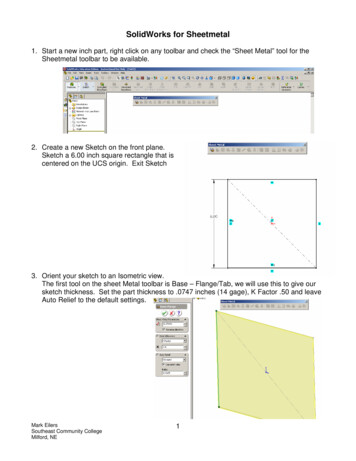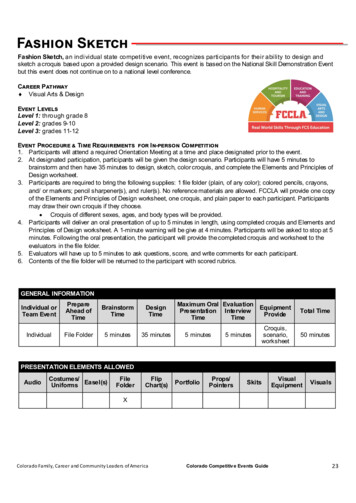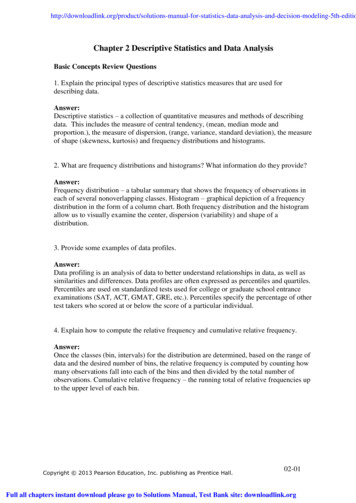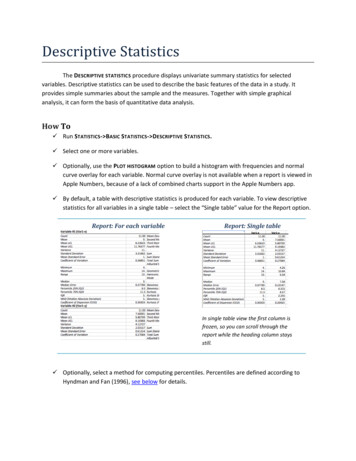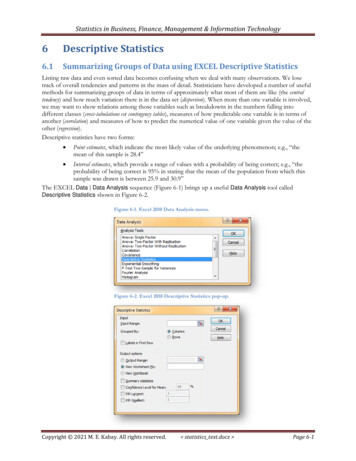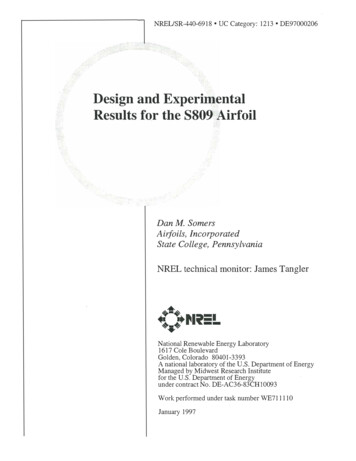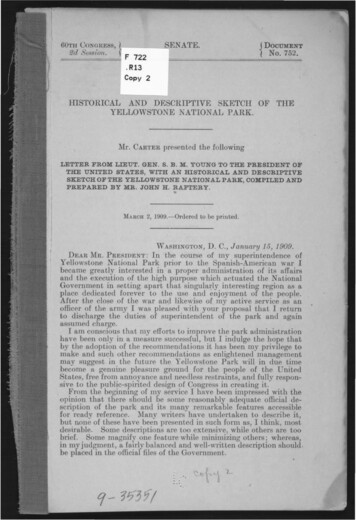
Transcription
L d Se' 0L F60TH CONGRESS, ENATE.J DOOUMENT722: "----,,,,-,-- ,--,--,, 1 N 0 . 7 5 2 . R13Copy 2HISTORICAL AND DESCRIPTIVE SKETCH OF THEYELLOWSTONE NATIONAL PARK.Mr. CARTER presented the followingLETTER FROM LIEUT. GEN. S. B. M. YOUNG TO THE PRESIDENT OFTHE UNITED STATES, WITH AN HISTORICAL AND DESCRIPTIVESKETCH OF THE YELLOWSTONE NATIONAL PARK, COMPILED ANDPREPARED BY MR. JOHN H. RAFTERY.\IMARCH2, 1909.-0rdered to be prillted.W MnIINGTON, D. C., January 1lj, 1909.DEAR MR. PRESIDENT: In the course of my superintendence ofYellowstone National Park prior to the Spanish-American war Ibecame greatly interested in a proper admmistration of it affairsand thp execution of the high purpose which nctllated the NationalGovernment in setting apart that singularly intel'estin region a aplacc dedicltted forever to the use and enjoyment of the people.After the close of the war amI likewise of my active service as anofficer of the army I wa pleased with your proposal that I returnto discharge the duties of uperintendent of the park and againa sumed charge.I am consciou that my effort to imfrove the park administrationhave been only in a measure succe sfu , but I indulge the hore thatby the adoption of the recommendations it has been my priVIlege tomake and such other recommendations as enlightened' managementmay suggest in the future the Yellowstone Park will in due timebecome u, genuine pleasurc ground for the people of the UnitedStates, free from annoyance and needle s res traints, and fully respon sive to the public- pil'ited de ign of Congre s in creating it.From the beginmng of my service I have been impres ed with theopinion that there should be ome rea on ably adequate official de scription of the park and its many remarks ble feature accessiblefor ready reference. :Many writers have undertaken to describe it,but none of these have been presented in uch form as, I think, mostdesirable. Some descriptions are too extensive, while other are toobrief. Some magnify one feature while minimizing other ; whereas,in my judgment, a fairly balanced and well-written description should.be placed in the official files of the Government. . .
"'1-1.-2(r 4 f i 't.HISTORICAL SKET('H OF YELLOWSTONE NATIONAL PARILMoved by this idea, I ventured on my own account and withoutexpen e to -the Government to engage the service of Mr. John H .Raftery, of Helena, Mont., and commissioned him to write a histor ical sketch and a concise description of that wondf'rland.Alter spending some time in the park in study and observation,Mr. Raftery prepared the descriptive article herewith transmittedfor your information and such disposition aE you may think properto make of it. As no language can convey a true impression of themany wonderful sights of the park, I have thought proper to aidthe description with photographs of a few objects of special interest,also photographs of certain of the first explorers of the country nowembraced within the park boundaries.My regular official communications have all been made in dueorder to the Secretary of the Interior, but since I have severed myofficial relation with the department I tran mit this communicationdirect to you, l\1r. President, because it was through your compli mentary request that I for the second time as umed the duties ofpark superintendent after nearly fifty years' service in the army.Very re pectfully, your obedient servant,S. B. M. YOUNG,Lieutenant-General, U. S. Army, Retired.To the PRESIDENT.YELLOWSTONE NATIONAL PARK.OTES-HISTORICAL AND DESCRIPTIVE.[Compiled and prepared by Mr. JOUN II. RAFTERY. under the direction and supervision of Lleut. Gen.S. B. M. YOUNG, U. S. A., retired, superintendent.)For a complete under tanding and appreciation of the Yellow stone National Park, whether as a pleasure ground, a health resort,or a place for scientil c investigation, personal and repeated visits toit are necessary. The accounts of its discovery, exploration, andestablishment as a national park have been written with varyingdegrees of accuracy, and writers of vivid fancy and contrasted liter ary qualifications have vied with one another in enthusiastic wordpictures of the phenomena, beautiful, sinister, or scientific, of thisp'remier wonderland of all the world. From every corner of the civ ilized world students and savants, poets, painters, and practicianshave come to witness, study, and describe the alternating manifesta tions of nature in spectacles magnificent or monstrous; and whileeach has contributed somewhat to the public's knowledge of thisincomparable region, the aggregate mass of their descriptive workyet falls far short of a complete and convincing exploitation of itswonders. Indeed, the scope of spoken or written language, the rangeof the human imagination, and the power of pigments spread uponthe artist's canvas become feeble, narrow, and almost impotent inthe presence of the majestic and outlandish marvels of YellowstonePark.Out of the vague, unwritten lore of Indian tradition come theremote rumors of an enchanted land among the mountains where therivers boiled, the earth burned and haunted lakes tossed spectralplumes of scalding steam into the zenith. Here in cauldrons of.,' .
HISTORICAL SKETCH OF YELLOWSTONE NATIONAL PARK.t,ir 13gypsum or ja"per or jade the evil spirits mixed their war paint, andnom peak and promontory, in the valleys, and on the hill. could beseen the spirnl smoke of their bule fires. The nomads of the N orth we t hunned it as a land of evil haunt or prowled about its marginsin awe ome fear and reverence. Sioux, Blackfoot, Crow, and Ban nock ventured to the verge of these demon-haunLed fnstnesse ,and intimorous Lruce made tores of arrowheads from the mountain of blackobsidian which looms abo\Te the river neur its golden gate. Beyondthat portal wa 11 realm of mysteriou and infernal portent. Lookingback a full century we find that the story of the Yellow, Lone Park is asequential link in the chain of epochal events which commenced withthe purchase by the United StiLLe of the then uncharted wildernesscalled the "Louisiana Territory," the subsequent expedition of Lewisand Clark, the discovery of gold, the conquest of the SaVtlges, and allthe epic deeds which achieved at last the winning of the West.Nearly a century ago (1 10) there returned from the wild of thenorthwe't one John Colter, a cout, trapper, and hunter, who hadbeen with Lewis and Clark in their hi toric expedition. It was uponthe return trip of the party that Colter, at his own reque t, was dis charged near the confluence of the Yellowstone River with the Mis souri. IIe had won the confidence and re pect of his commanders,who supplied him with food and ammunition for his new venture.With two companions Colter then set out for the headwater of the:Mis ouri, t1'l1pping, hunting, anfi trading in fTiendly commerce withthe Indian. Colter seems to have been a man of almo t inliniteendunmce, cO 'lrage, and perseverance. The record of his doings fromAugust, 1 06, when he parted with Lewis and Clark, until the springof 1807 i not extant, but early in the latter year he arrived at themouth of the Platte River in a canoe. There he met :Manuel Lisa,the fn,molls fur trader, who was organizing a trapping and huntingexpedition into the very regions from which Colter bad come. Sotimely a prize as the services of Colter wa not to be overlooked, andhe was indured to return into the wilderness with the Lisa party.Maj. Hiram M. Chittenden's book, " The Yellowstone," in many re spects the best that ha been written about this national park,devotes considerable space to the activities of Colter, who was unque tionably the first white discoverer of the region. For it \Va in 1 07that he pa ed through the Yellowstone wonderland, viewing for thefirst time the boiling pring about the lake, the tar J?rings at thefork of the hoshone, and kirting the Yellowstone Rlver from itssource pa t the upper and lower falls to the ford above Tower Fallsand thence to Li a's fort. ·Wounded in battle between the Crows andBlackfeet, alone, ill-provided with ammunition or food, the intrepidColter traversed on thi journey afoot hundreds of miles of the wildestand most rugged country on earth. IIe had hardly recovered fromthe effects of his hardship when Li a sent him back to the hostileBlackfeet for the purpo e 6f opening up trading negotiations withthem. Nothing daunted by the fact that he had appeared with theCrow in battle against them, knowing that Lewis had lllin one oftheir number, Colter, in company with a single comrade named Potts,adventured back into the hunting ground of the Indians on the upperMi souri. Paddling up that river one morning the two trappers weresuddenly surrounded by a swarm of more than 500 Blackfeet warriors,who lined either shore and bade the white men land.
4HISTORICAL SKET H 01 ' YELLOWSTONE ATIONAL PARK.As the ' did so an Indian seized Pott' rifle, but Colter, who was amighty man, wrenched the weapon from the red man and handed it toPotts. The latter in 'panic leaped into the canoe and pushed it outinto the stream. An arrow truck rum, and crying out: "Colter, I'mwounded," Potts eized his rifle an .l hot hi ' assailant dead. Ahower of arrow. from the enraged savages ended the life of Pottright there. ·W hether he used his rifle to invite a sudden .leath inpreference to the prolonged torture which he anticipated at the handsof his captors wil1 never he known, but his commde wa quickly dis armed and stripped naked a for the torture. After the Indian hadconferred they asked Colter if be was a good runner. The chance ofmnning the gantlet or being chased by .500 fleet-footed so,vage bentupon hi murder gave him a pale gleam of hope. and although he wasreputed one of the speediest and most enduring runners of the 'Vest.he told the chief that he was both weary and slow. They led himthree or four hundrell yards out upon th(' prairie and bade him runfor his life . Barefoot, nude' , with half a thousand screaming demonat his hack, but with the indomitalle courage of a man who loveslife, he ran a ' no white man ever ran before. His feet and leg werepierced with hundred of the thorns of the prickly pear, blood spurtedfrom his no e and mouth, and his breath Cilme only in tentoriouga ps 1efore he ventured to look back.lIe had gained on all of his pur uers except one, an agile young war rior, who, with brandi heel pear, was wiftly closing down upon him.With sudden de peration Colter tood stock still. The Indian, intrying to do likewi e, stumbled and fell. The badly-launched spearstuck in the ground and was broken off. The hunted white manseized the barbrd half, impaled rus fallen foe to the earth, and set offwith renewed vigor for the JeJfer on Fork of the li ouri, which henow aw gleaming through the tree. He had run more than 6 miles.He was covered with blood, his feet were torturing him, but he gainedthe fringe of willows by the river, and saw hi enemies yelling andscreaming about their .lead brother. A raft of driftwood, snags, andbranches accumulated at the head of a sandbar do\vn tream fromwhere he stood caught Colter's eye. lIe dived into the river, and,wimming under water, came up within the helter of the drift.Search a they would, the Indians could not find him, and concluded.he was .lrowned. He kept hi hiding place till night had fallen, andthen, chilled by the icy water, footsore, hungry, weakened from losof blood, and tark naked, he truck bravely into til(' fore t for aseven days' truggle back to Li a' camp. He reached it after a weekuch was the manof the most exquisite agony, toil, and exposure.and uch the trials which give to John Colter an enviable and endur ing place amongst the really great explorers of this country. JohnBradbury, in his "Travels in North America," is authority for mo tof the detail here mentioned, and so ably and accurately writtenwas the book of the English naturalist that"Yashington In;ing in his"A toria" uses the Bradbury text with but few alterations.Coming back to t. Louis in 1 10, John Colter' tales 'of almo tincredible ventures, di coveries, IUld hard hips were scouted by mostof hi hearers, but he \Yon the respectful attention of Gen. WilliamClark, who knew him, and of Henry M. Breckenridge, the author, andJohn Bradbury, whose writings have been sub equently authenti cated by the e. plorations and researche of core of dependable
HI TORICAL SKETCH OF YELLOWSTONE NATIONAL PARK.5authorities. Coulter's journey through what is now the Yellow tonewonderland took him in a g('nerally northeast direction from thesouth"ll terly corner of the park, and, nlthough he saw the hot springsabout the Yellowstone Lake and River, nnd must hnve passed closeto both the upper and lower fall, he makes no mention of the latter,nor did he catch a glimp e of the gr('at g('yser of the upper and lowerbasin, nor the mammoth hot prings, nor any of the other marvelsexcept the tar sprino-s.In 1 0 Col. P. 'iV. Korri , then superintendent of the pnrk, dis covered what is believed to be, after Colt!:'r's, the oldest r!:'con[ of thepresence of th!:' whit!:' man in thnt region. In a ravine about halfa mile above the upper falls Colonel K orris found all anci('nt treeupon th(' bark of which, partly over grown but yet deciph!:'T lhl(', wasthe in cfiption "J. O. R. Aug. 19,1 19." Car!:'ful investigation of thenames and exp1.oits of all th!:' enrly tmpP(,l"s, hunt!:'rs, and cout bafailed to evell r!:'mot('ly indicate th(' id!:'ntity of J. O. R. Althoughthe dat!:' of the inscription wa YNiiied by counting the annual ringupon an adjacent tree, and though now nearly obliterated, it r('mainsa proof that white m!:'n visited tb!:' park after Colter and full futyyears before its flnal discovery. In 1 7 , in caches by Beav!:'r Lakeand the Obsidian Cliff, Colonel Xorris found marten traps of a patternused by the Hudson Bay Company a ll llf century previous; and atth!:' foot of lount 'iVa hburn, near the rim of the Grand Canyon,Frederick Bottler fountl the ruins of a block house of incalculableantiquit),. The ' "ashhw'n-Langford expedition of lR70 found near1Ilud G!:'yser, on the east bank of the Yellowstone River, an old di mantlel!' pit or trench which might have b!:'en u ed a a plnce of con cealment for hunters of waterfowl.In 1871 Mr . Frances Fuller Victor pubJi hetl a book, "Th(' Hi vel'of The "\r est," which is a sort of biography of a pioneer trapper namedJoseph M!:'ek. In 1829, when th!:' Rocky Mountain Fur Companywithdrew from the field tlwn dominated b)' the Hud on Bay Company,Meek, who had been in the !:'mploy of the former under Cnpt. \\illiamSublette, was 10 t from his comrad('s and wantlered. for s!:'veral inysuntil he wa found tarving and half crazed by two of his party.There i no doubt that he wa ' nt one time in the hot spring:,; districtof the park, for he el!:' crib!:' in his diar:v n, "whole country smokingwith vapor from boiling , pring ,and burning with go. es issuing fromsmall cmt('l"S each of which WtlS emitting a sharp, whistling sound.* * * Interspersed among these on ' the level plain were Jarg!:'rcrater, some of them from 4 to (j miles across. Out of th!:'s(' craterissu('u blue flames and molten brimstone."Allowing for po sible exaggenltion, Meek's a ertion that fire and.brim tone is u('d from the!:' craters is not wholly un ub tllntiated.Writing in 1 ] 1, H!:'nry l. Breckemidg(, say : '· ir. Lisa informs methat ttbout 60 mil!:'s from hi fort (H,t the mouth of the Bighorn) ther!:'is a volcano that actually emit fhtmes." :Major Chitt!:'n(len antiothers of like sincerity und diJig!:'nce llllVe concludNI from this undother early \\ ritings nnd trildition thllt there wu. volcanic activity inth( Rocky Mountains a Inte ns the be inning of th( Ilin('teenth c!:'n tury. To "Warren Angu. Ferris, a clerk for the Americnn Fur Com pany from 1 30 to 1 40, Chittenden gives the honor of huvillg writtenthe flrst actuul description of the Fin-hole Geyser Basin. Returningfrom hi station in the Flathead country in the pring of 1 34, Ferris,
6HISTORICAL SKETCH OF YELLOWSTONE NATIONAL PARK.yet incredulou of the mal'velo s talco he had hearc of .the boi ingfountain of tIll' Yello\\;;tone reglOn, took t\\0 Pend d OreIlle IndlallSwith him and followed up the Firehole RiV!.'r. On May 20, 1834, hewoke in full view of th(' outlandish phenomena of the Upper Geys('rBa in convinced at lust and exclaiming, "The half has not been toldme." , Ferris's journal of this adventure was Fublished in 1842 andproves conclusively that the great geysers ha been seen and appre ciated 10nO" before I l 70, when the \V tlsh hurn-Langford expeditionmade the fir t and ultimately adequate explomtion of the park, anachievement which culminated in the erection and pre ervation of themost maCTnificent, the large t, and the most eventful na,tional plea mepark the"'world has yet known. Father De Smet, the famous Jesuitnil ionary, writing in 1 '5'2, was the first to give an accurate geo graplilcal definitio!l of the geyse district, loea.tmg t tJJ.en wi h preci sion both as to latitude and longItude. GunDlson. mIlls" IIIstorv ofthe :Mormons," puhli hed in Ib52, like rather De Smet, drew nluchof his informalion about the Yellowstone country from Capt. JamesBridger, the famous frontiersman whose strange yarns of the marvelshe h,ld there Leheld remained discredited or ta hooed by such writersa IIayden, \Yarren, Raynolds, and others tlS lote tlS 1860. The firstgovenimenttll expedition sent expressly to explore and chart what isnow the Yellowstone K ational Park set out in the early spring of 1 59under command of Capt. W. F. Raynolds, of the corp of topographicalengineers of the United tates Army. lIe did not reach the actuallocality of the park until the ummer of 1 60, nor did he ever pene trate the valley of the upper)' ellowstone , so that except for a map inwhich, as he lUJ1l;;elf admits, the most interesting portion of the regionremains a "terra incognita," Captain Raynolds's expedition yieldedlittle of accurate information about the central glorie of the Yellow stone Park. Immediately upon his return the national electionbrought the country face to face with armed rebellion; disruptionthreatened the Uillon, peaceful pursuits were abandoned, the militaryestablislunent wa mustering for war, and the we tern wonderlandwas left to slumber in the memories of the few who had seen it orheard about it.From 1 63 to 1 69 the northwestern hegira was made up of goldseekers, hardy ndventurers, and prospectors, drawn thither by thedi covery of the great placer mL'1eS of Montana. ,ometime. in pairs,but oftener in group!: , they wandered into the confines of what is nowthe national park; but with their hearts et only upon mining andtheir minos feverish with the thirst for gold, they gaye but it cur:sory!5lance nt the stupendous wonders which then first came within theirken. In August and September of 1863 we find Walter W. De Lacyleading a band of prospectors into ome theretoforf' unknown sec tion of the rrgion. They traversed the hot, prings locality eaRt ofYellowstone Lalw, camped at the junction of the Snake cmd Lewisrivers, explored the Pitchstone Plateau, descended Moose Creek "nl ley, discovered the true drainage of Shoshone Lake, passed throughthe Lower Geyer Basin, cn unUy witne sed the play of the GreatFountnin Geyer, and went out via the junction of the Gibbon a.n dFirehole river. Finding but scant indications of gold, the e, hkeother prospector' who passed through the park between 1863 and1 69, gave slight heed to the cenic splendors through which theypassed; and yet their unavoidable reference to the geysers, springs,
HISTORICAL SKETCH OF YELLOWSTONE NATIONAL PARK.s,7canyons, and rivers served in a cumulative Wtty to whet the interestand focus the attention of men in whom science, sentiment, and thepas ion for adventure were already making for the ultimate exploita tion of the world's wonderland. De Lucy in 1863, James tuart in1 64, George Huston in 1866, and two prospecting parties in 1867contributed much to the waxing fame of the paradi e that had untilthen been regarded as remote, if not as imagmal'Y us the mountainsof the moon and the valleys of the shadow.As early as in 1867 prominent and prnctical men of Montana ha(been earnestly considering an extensive, thorough, and scientific ex ploration of the region from which so many strange tales had come.Party after party was organized for the venture, but the uprising ofthe hostile Blackfeet and the, poradic forays of other savage tribesdiscouraged and dismayed them all until 1869. In that year DavidE. Folsom, a qualified surveyor of Montnna, and C. \Y. Cook, bothmen of excellent education and alert intelligence, determined to waitno longer upon the doubts and fears of their neighbors of Montana, andon September 9, with provi ·jon for six wer.ks, and only one man,William Peterson, accompanying them, they set forth from DiamondCity. 40 mile from Helenll, font., flH' an expedition that first won andcommanded popular intere t in the new Eldorado of' my tical beauty.Reaching the Yellowstonr. River ncar the ('onfme of the park theyfollowed its eastern shore line and reaehed the falls on eptember 21.They cro sed the river above the now famous cataracts, examinedSulphur Mountain and the adjllcent hot springs, followed the westernmargin of the river past Mud Geyser and the Emerald Grotto, re crossed the river nt the outlet of the IHke and skirted the ell, tern andsouthern shores of the extreme western arm. Thence they headed forhoshone Lake, viewing in turn the beauties of the Fil'ehole Riverand the awesome spectacle of the Fountain and Excel ior geysers infull eruption. For the first time alRo they Raw and recitC'd the weirdand wraithlike manifestations of PrisJl1atic Lake and the carcely lesswonderful cone, craters, pools, and springs ,,-hich are scattered aboutthat formation in bewiluerin variety and profu ion. Awed by themajestic si hts which they had witnessed nnd dau'cl by the porten tou demonstrations of the subterranean inferno over which they hadpassed in trembling safety, they went out of the country through thevalley of the Madison RiYer, hringing t.o the outside world the firstsequential and convincing account of the facts which up to that timehad been consill{'red as preposterolls and visionar.V.Returning. to Helena, where their rC'putation for ,eracity was ashigh as their Imown courage amongst the h'ading men of the Territory,both Folsom and Cook refusC'd to risk their reputations by tellingtheir experiences to a promiscuous crowd. Gen. Henry D 'Washburn,the surveyor-general of rontana; Gov. Samuel T. Hauser; TrumanC Everts, ex- nited States a e or for :Montana; Nathaniel P. Lang ford, who afterwards became first superilltC'lldent of the national park,all gave wondering heed ancl credence to the tatements of the home comers. New plans for a larger and more exhaustive exploration ofthe wonderful region were now made. GC'lleral Sheridan, who vi itedHelena at that time, became vastly illterested and gave a sUfIlncesof military aid to the proposed expedition.Mr. Folsom, who was rarely gifted as n writer as well as an observantexplorer. then wrote a concise. logical, and. equential account of the
8HISTORICAL SKETCH OF YELLOWSTONE NATIONAL PARK.marvels which he alld . 11'. Cook had witnc sed in the Yellowstonecountry, and sent it to Hfirper's.:Mag ine . The ditor of that publi cation, a tounded by the audacIOus Imag1l1mgs of the auth 7 andwholly incredulous a to the tatemcnts made in it, declined thearticle and returned it, to its chagrined author. It finally gainedpublication in the We tern Monthly, of Chicago, but not until thecopy reader had eliminated mAny of the most interesting passagesbecause they were con idered "ultramontane" in both a literal and afigurative sense. "W ith the exception of the publisher' proof, whichpassed into the hands of :Mr. Langford, the whole i sue" of the maga zine containinO' Mr. Folsom's story of the park was destroyed by fire.In later years 1r. Langford, at his own expen e, printed and distrib uted 500 copie of the narratin' nnd donated the original to the:Montana Historical ociety, which yet retains it among the treasuredarchives of the State.The plans of the Washburn-Langford party took tangible form inthe spring of 1870, when MI'. Langford visited Major-Genend Hancockat St. Paul, outlined the propo ed expedition, and secured from hima promise of a military egcort. Samuel T. lrauger also visited GeneralHancock about that time, so thnt on August 17, 1 70, "hen the party,equipped for a journey of fOllr week 'et out from Bozeman, Mont.,it wa known that orders had already been forwarded to Fort Ellisproviding a military escort of one lieutenant, one sergeant, and fourenlisted men. FOUl'teen civilians, with a train of pack and saddlehorses, adequately armed nnd equipped with the essential scientificinstl'l1ment and commanded by Geneml "\Yashbul'll, "itS reinforcedat Fort Ellis by Lieut. GustaYlI'l C. DOtl1le,ergeant and fourtrooper of the Second United 8tates Cavalry, and constituted thenone too formidable cavalcade which then rode into a wild regioninfested with hostile Indinns for the fir t and mo ' t consequentit11exploration of the Yellowstone wonderlnnd. The party, thoughshadowed by roving bands of prowling savages, arrived" ithout mis hap at the mouth of the Gardiner River on August 26, entering thepresent domain of the park not fitr from thf' northen gate, ay, thepre ent site of the tately luul magnificent lava arch. Holding to thetrail, ,yhich led along thp left bank of the 1'ello\," tone, the partymi ed the Mammoth lIot'pring' altogether, encountering, first, thefa cinatingly beaut iful onders of the cn cude ' and spire of To\,. erFalls, and coming lip on the initial apparition of the Grand Canyonitself on the ea tem flank of "hat" it " a mountain, soon named IountWashburn. The eagel' spirit of their leader prompted General Wa h burn then to adventure from the camp alone in search of signs thathe v'as leading hi party aright. He gcnled the rugged sides of theprecipitong mountain, and, from it bald and rusted summit far abovetimber and now, hie:; eye for the fir ,t time swept over that panort1mawhich in its magnificent extellt, variety, and Titanic majesty ha notbeen equalled in the known world. Perched upon the pinnacle rock,a central atom within tlll il1 :I'edible amphit,heater, he looked in alldirections aero, the overmHstcring silenc to where the l'I1gged peaksof the Grnnd Tetons, the ALsarok'ls, and countle' s unnamed moun tains rose up again t the cloudless blue like the encincturing 11mlcrenelitted battlement of un unknown kingdom. He aw, too, far tothe southeast, the far-sprettd, ghining waters of Yellowstone Lake,the focal point of the expedition and, nearer, e't, but only as ,1 darkAI.
TIl TORICAL SKETCH OF YELLOWSTONE NATIONAL PARK.9go, h ncros the green tunic of the valley helow, the winding outlineof the Gmnd Canyon. Across through the pale haze that hun IY abovethe y·\lle)'R more remote he could descry the flaunting jet 0 f steamupri 'ing from the geysers, ltnd all about, on gra sy uplttnd, by thelu h brink of brook or pool, und upon the rock- trewn inaccc iblepromontorieH, he could sec elk, deer, and mountain· sheep like tinyspecks of brown and white upon the green.Tha account of that day's adventure heartened his tired companyto new and zealous effort. They pushed on next day, following thebrink of the t1eepening cunyon of the river to camp within sound ofthe mighty falls of the Yello\'\", tone. Only the hundreds of thou andsof touriRts who haw witnes ed the astounding combination of majestyand beauty accomplished here by nature can realize the rapt a tonish mcnt ,.,,--jth which these men of the 'Yashburn-Langford C'xpetlitionfirst gazed upon the falls and eunyon of the Yellow tonC'.Ollle ofthem, men who, for all their early nature had been hanlenN] by yearsof adventure, warfare, hartlslup, and di appointment, Rat for hoursupon the dizzy rim of the canyon guzing into its unearthly abysses,bound by the spell of its illdC'scribabl(' beauty, and choking the sobsforced from their start]rd hearts by the unspeakable and port('ntouswonelers which thrir eyes saw but their minds could not encompass.N'or ean th,e extraordinary emotions of the ' e ad,enturing nH'n heascril)('d in any drgree to th!'ir lack of pre\'ious deRcriptions; 1 '01 som'R worel picture of the wonders h(' had witnessed in 1 69 remainseyen now one of the most graphic, convincin , and detailed accountsof his experience, and the men of the 'VaRhburn expedition had l'('ad itor heard it from hiH own eloqtl('nt lips.ince then thr world has beenwidC'ly and well advised of what the traveler may expect wh('n heshall gazC' upon the strange sights of the Yellowstone National Park;the fancie" of rlcRcriptiv(' writers have been wrought into fine frenziesin attC'mpts to rralize its phenolllrna for readers of all tongueR andtribC's; y 'ar aft!'!' year the paintC'rs comr to limn its harning outlinesand to catch and fa"ten down fOl'r,('1' th(' radiant glories of itR color ing; trav('ler.' from eYC'ry corner of the world have come to contrastit with the wond('t' places of th('ir wandcrings. And all of them havecome to know and admit that the language which can tl'l1 its toryi tIDwrittC'n and unspoken of lllan; that there i no palette wideenough to ea!'ry the colors, shades and tonrs which nature broughtto itR crcatioll: that comparison becomrs futile and is forgottcn inthe p!'C'sencc of maryels without their counterparts 011 the globe.The party had now followed the rim of the canyon for almost 30miles. Commencing its swift descent just above the upper falls, thedescending chasm gains 200 feet in depth where the fir t waterfallplunges to the new level of the river; thence for a half a mile, foamingover gigantic bowlders and la hing the precipitous walls of the deep
the fn,molls fur trader, who was organizing a trapping and hunting expedition into the very regions from which Colter bad come. So timely a prize as the services of Colter wa not to be overlooked, and he was indured to return into the wilderness with the Lisa party. Maj. Hiram M. Chittenden's book, " The Yellowstone," in many re


